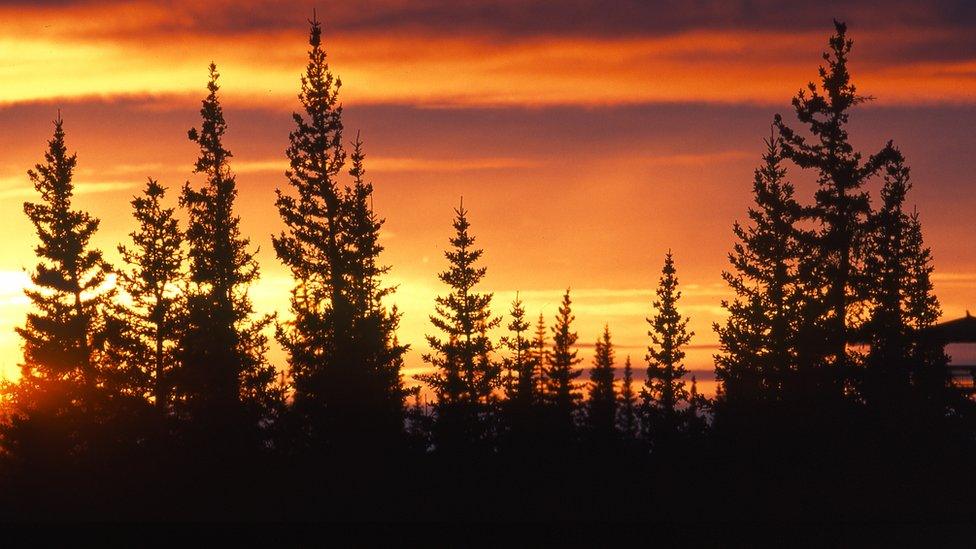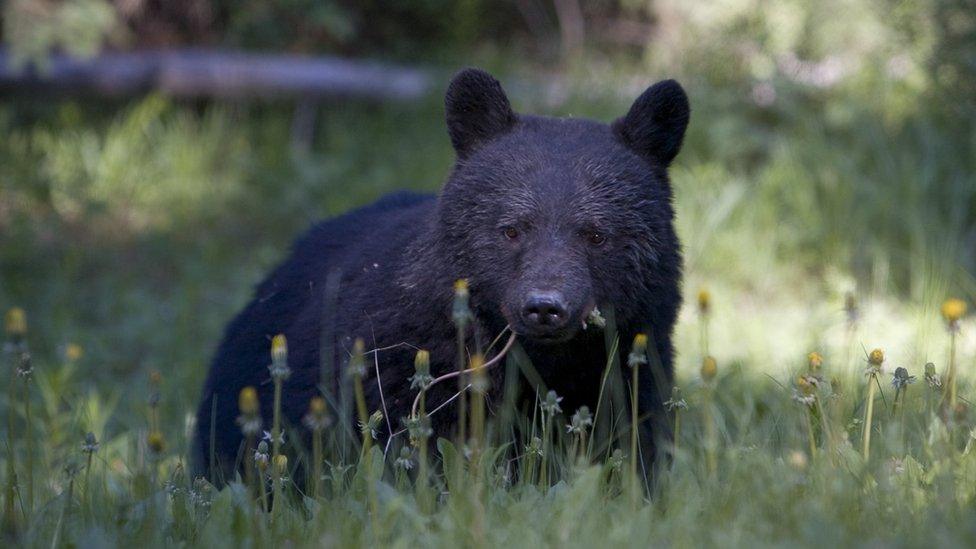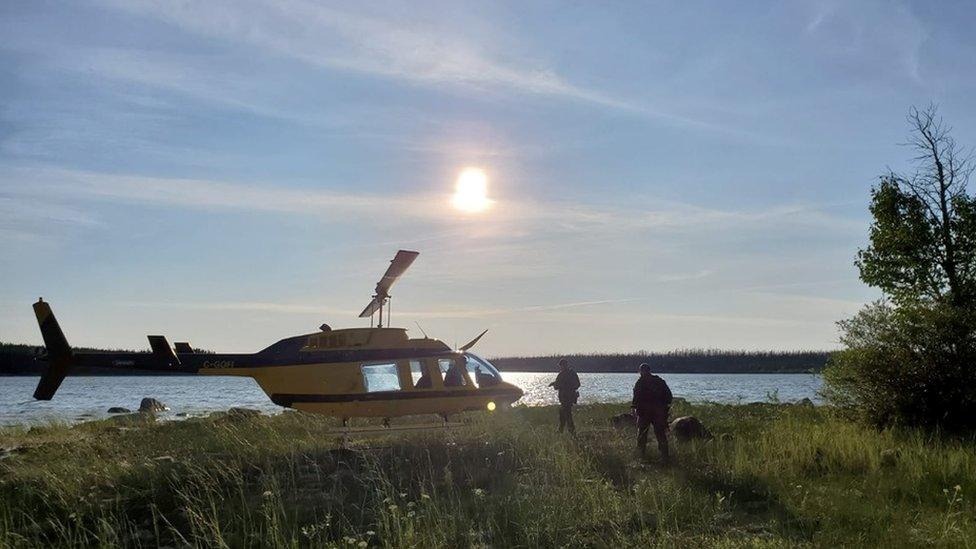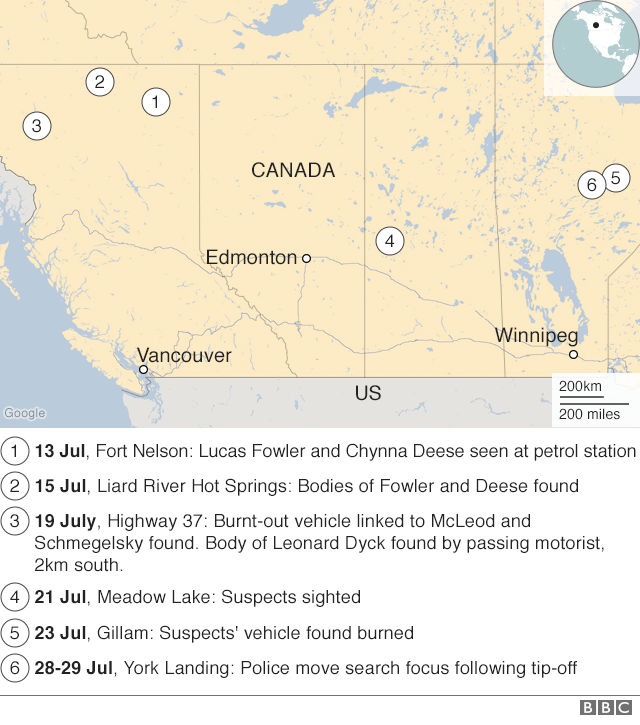Kam McLeod and Bryer Schmegelsky: How to survive in Canadian wilderness
- Published
Manhunt for suspected killers hits Manitoba
Canadian police have been searching for a week for two teenage murder suspects who are believed to be hiding in a remote region of northern Manitoba. How hard is it to survive in the Canadian bush?
Police suspect that Kam McLeod, 19, and Bryer Schmegelsky, 18, killed three people earlier this month in British Columbia before driving about 3,300km (2,000 miles) east, leaving two burnt-out vehicles in their wake, and disappearing into the Manitoba wilderness.
A massive manhunt for the pair is under way and, after a recent search around the community of York Landing, it is now focused on their last confirmed location - Gillam, Manitoba - and the surrounding woods.
Dave MacDonald, lead instructor at the International Canadian School of Survival, knows the area well.
He did search and rescue work with the Royal Canadian Air Force for 19 years and has spent time in the region as an outdoor enthusiast.
It's remote and sparsely populated wilderness, covered in dense boreal forest, bogs and swamps, rivers and lakes. It's filled with "lots of critters" - black bears, the odd grizzly or polar bear, moose, wolverines, wolves, minks, otters, and grouse.
This time of year, "there'll be blueberries pretty much everywhere, cattails and roots," says Mr MacDonald.
"You can do a lot if you know what you're doing. If you don't know what you're looking for and you don't know what you're doing, you'd have a very difficult time."

Manitoba's boreal forest at dawn
Anyone trying to survive would need some basic skills, he says.
That includes knowing how to manage exposure to the cold and the heat, how to build fires and shelters, how to find and purify water and how to obtain food.
Finding something to eat is not the end of the challenge, however. There is the added problem of needing to clean up after your meal.
One wildlife threat probably comes from the bears. Food attracts bears to camps, which is why it's recommended you hide your food in bags in trees, for example if you're overnight in bear country.

Black bears and other bears can be found in the region
The average temperature in the region in mid-summer is about 22C (71F) during the day and about 10C (50F) at night.
Rock outcroppings, thick stands of trees, and empty cabins - used for hunting and fishing or as vacation homes - along the waterways could all provide possible shelter.
Mr MacDonald says dehydration is always a concern for anyone in the wild, and can lead to injuries from falling or tripping, or put a person at a higher risk for hypothermia or heat exhaustion.

Police continue their search for two teenage fugitives wanted in the murders of three people
Then there are the insects.
"The bugs can drive you crazy," he says.
Mosquitoes thrive at night and in the shade and "when you step out into the sun, the mosquitoes aren't there, [but] the black flies take over, so do the deer flies. And they can wreak havoc on you as well".
It might be a challenge but it's very possible to survive, says Mr MacDonald, who recalled two cases in recent years.
On Monday, Manitoba RCMP found an 84-year-old grandmother who had been missing for four days in the wilderness after being separated from friends while picking blueberries. She only had minor injuries.
In 2017, two young German tourists walked over 100 km in 11 days in northern Manitoba after their canoe was damaged. They were relatively unscathed when they finally reached the highway leading to Gillam.
Allow X content?
This article contains content provided by X. We ask for your permission before anything is loaded, as they may be using cookies and other technologies. You may want to read X’s cookie policy, external and privacy policy, external before accepting. To view this content choose ‘accept and continue’.

Police initially considered Mr McLeod and Mr Schmegelsky missing, but on 23 July police named them as suspects in the deaths of Chynna Deese, a 24-year-old American, and her Australian boyfriend, Lucas Fowler, 23. No charges have yet been laid in that case.
The couple were on a road trip in Canada and are believed to have been shot and killed in mid-July.
Police have charged Mr Schmegelsky and Mr McLeod with second-degree murder in the death of Leonard Dyck, 64. His body was found on 19 July.
The two are considered "armed and dangerous" and the public have been warned not to approach them.
Little is known about equipment they may have with them or of their experience in the wilderness.
Sherman Kong, founder and chief instructor of Maple Leaf Survival, told the BBC that the two have the added burden of being on the run.
They may avoid using any firearms in their possession to hunt or to scare off wildlife for fear of being spotted, might be wary of lighting fires, and skip the shelter of cabins to avoid detection.
People who find themselves lost in the woods are often advised to stay in one location, which makes it easier for search teams to find them.
But both Mr McLeod and Mr Schmegelsky could be on the move over rough terrain, meaning they would likely be tired and hungry.

Mr Kong says their mental state will be as much of a factor as their outdoor experience.
"You can have all of the gear and all of the training and none of that means anything if in a real-life situation you panic, you lose the ability to think and it all goes out the window," he says.
Despite the best efforts of the Royal Canadian Mounted Police, searching along with military air support, it will be difficult to find the two - if they are still in the area.
Police say it's possible the suspects inadvertently received assistance and are no longer in the Gillam region.
"It's a needle in a haystack in that area. Unless you have a cooperative target trying to signal, it's very difficult to see anything," says Mr MacDonald.
"I've done month-long searches and seen no clues as to what happened to people, and we never did get closure."
- Published29 July 2019

- Published25 July 2019

- Published25 July 2019

- Published27 July 2019
